Whether it’s your horse’s soundness or age—or your own busy schedule—that keeps you out of the saddle, managing a horse that’s not ridden often can be a challenge, especially if you have specific riding goals. Here you’ll hear from three experts who specialize in helping amateur competitors and recreational riders get the most from their horses even with reduced activity levels.
[READ: Finding (Making) Time to Ride]
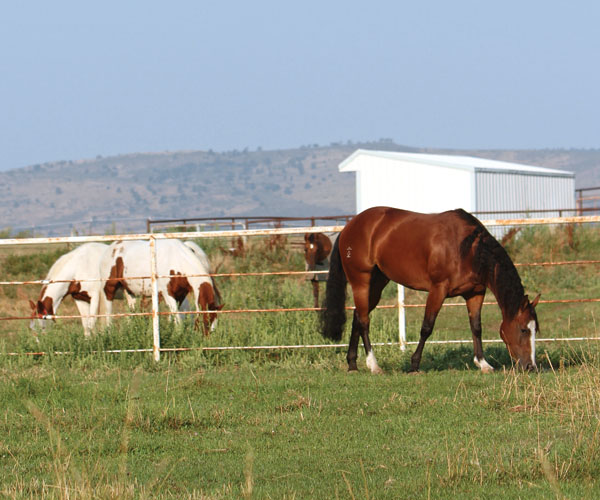
Although riding as often as possible is the ideal, these five strategies will allow you to keep your horse on track, even given your limiting circumstances.
1. Maximize the Time You Do Ride
A horse that’s still learning can pick up new skills while ridden infrequently, only at a slower rate. You’ll need to be especially deliberate in your approach because your horse’s lack of conditioning will limit his ability to stay engaged for a long lesson. A horse that’s well trained won’t lose his skills and fundamentals just because he’s not ridden daily. With either level of horse, approach each ride with a plan to ensure that you make progress whenever you do ride. (Note: If your horse has soundness issues, try one of our unmounted strategies after checking with your veterinarian.)
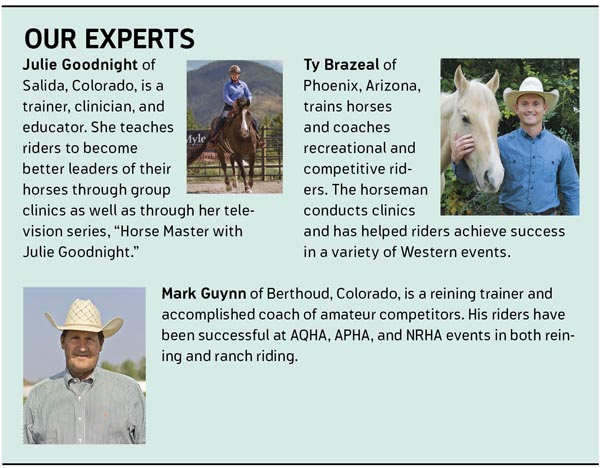
From the start, be careful not to waste your horse’s energy or reach a point where he’s exhausted and resents learning. Ty Brazeal suggests starting each ride with a review of the basics.
“Don’t assume you can get on your horse and pick up right where you left off days, weeks, or months ago,” he advises. “Revisit what he knows first, so you can give him a chance to be successful, which will help build his confidence.” This review could be as simple as walking him in circles while flexing and bending.
As you warm up, do a basic check of his foundation skills. If he’s rooting at the bit or resisting lateral pressure, for example, refresh these skills before you move on. Determine what you’ll work on in a session, such as a drill or a specific skill. Practice that until you see improvement, then call it a day. Always end on a high note so your horse feels confident and as if he’s been able to please you. A major part of keeping your horse happy is maintaining his sense of accomplishment and ensuring that he’s not mentally exhausted.
The same is true of his physical condition. He shouldn’t be so fatigued after a ride that he’s unhappy.
“A horse that’s seldom ridden, but ridden to exhaustion each time you saddle up, will be sore and become resentful,” warns Julie Goodnight. “You either have to spread his exercise workload throughout the entire week, or not ride him so hard on the days you do ride.”
2. Brush Up on In-Hand Work
Many exercises done in the saddle can be replicated on the ground and may be your only option for a horse that can’t be ridden due to unsoundness, age, or your own physical limitations. And even for horses that are able to be ridden, practicing in-hand work for short intervals during the week saves you time by eliminating the saddling and unsaddling process; plus the skills developed will also transfer when you do saddle up.
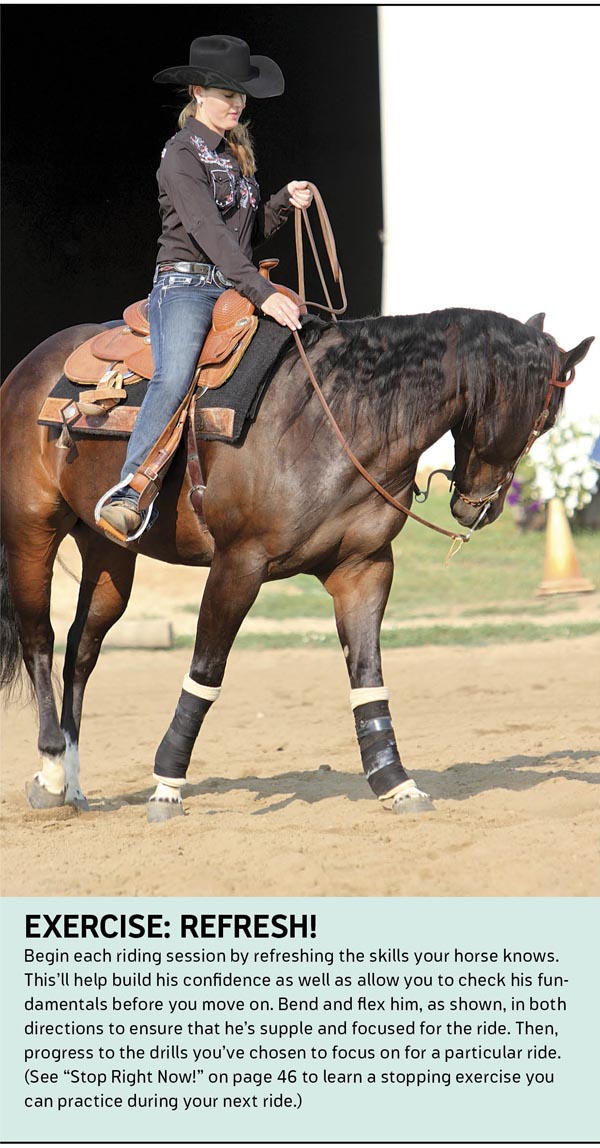
Mark Guynn says brushing up on your showmanship skills is an excellent unmounted exercise for any horse.
“Find or make up your own showmanship pattern to follow,” he says. “Set out cones, map it out, and run through it.” Your horse will improve his ability to follow your body language and cues as he stops, pivots, sets up, and sidepasses on the ground.
“These are all foundational skills your horse should have, no matter if he’s being ridden or handled in-hand,” Guynn observes. So, even if you don’t plan to show, practicing showmanship patterns will establish basic skills and keep training sessions interesting. Choose a speed that’s comfortable and controlled. If you or your horse are physically unable to trot, keep your work to a walk and spend more time working on maneuvers, such as sidepassing, pivots, and backing.
Brazeal agrees about the usefulness of in-hand work.
“Even if you only have 20 minutes to spare,” he says, “you can put your horse in a halter to practice drills that’ll teach him to yield to pressure so you can establish control of his shoulders and hindquarters.” Use your body language or pressure from your hand to push your horse’s ribcage over for a sidepass, or his shoulder to initiate a pivot. Mimic the pressure, both in strength and position, that he’ll experience when you cue for the same maneuver in the saddle.
3. Get His Exercise In
If your rarely ridden horse is stalled, it’s important that he be turned out or longed regularly to enable him to expend excess energy. Longeing can be an excellent way to exercise your horse and further his training at the same time. Keep in mind, though, that the purpose of longeing isn’t to allow your horse to mindlessly run circles around you.
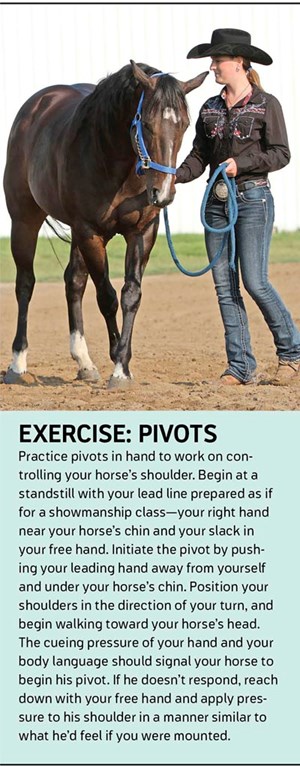
“The same rules of good movement should be applied to longeing as with riding,” Brazeal stresses. Practice using your body cues to move your horse in or out in his circle and stop. Begin your practice at a walk. Once he’s yielding to your body pressure and cues, then progress to faster gaits. Work to sharpen his responsiveness as you move him through the various gaits and modify his speed within those gaits. If your horse has soundness issues or is coming back from a layoff or injury, choose a pace that’ll challenge him physically but won’t be too taxing. (Note: You can work your horse in a round pen instead of on a line, though working him on a line gives you more feel and control.)
[READ: Feel-Good Workout for your Senior Horse]
4. Remind Him of His Manners
The most noticeable result of an irregular handling routine is declining manners. Your horse’s pent-up energy or lack of consistent rules may cause him to be impatient, to push into your personal space, and to generally show a lack of respect.
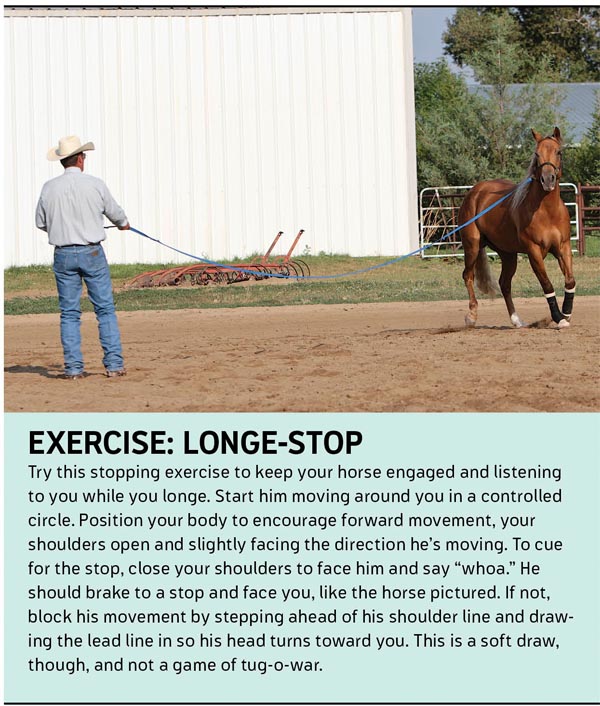
This means that every time you interact with your horse, you must reinforce basic manners. These include patience while tied; leading well; and standing quietly while being groomed, saddled, trimmed, shod, or otherwise handled.
Guynn suggests leading your horse “with conscious awareness of what he’s doing, how he’s managing his pace and space, and whether or not he’s attentive to you.” If he’s crowding or bullying you or not rating his walking pace to yours, correct him. If he’s too close, quickly back him several steps so he’s reminded to maintain your personal boundaries. If he’s trying to walk too far ahead of or behind you, stop or slow him down or encourage him to keep up with you with clucks or authoritative bumps of the lead line. Remember: When he’s listening and respecting you on the ground, he’ll also do so under saddle.
Goodnight recommends that you also be aware of behaviors you have that might be prompting your horse’s poor manners. For example, if you routinely give him treats at set times, he’ll eventually come to anticipate them and express outward irritation such as stomping his feet or nudging you until you “hand it over.”
“If the horse is acting and you’re reacting, then the horse is controlling you,” says Goodnight. Establish yourself as an authority on the ground so you can maintain this role when you ride, too.
5. Maintain the Bond
If the majority of your time with your horse is spent feeding, cleaning waterers, mucking his stall, or grooming him, don’t sweat it. Even this time can help you maintain a connection with your horse. Brazeal suggests that at the very least you try to spend quality time with your horse if you’re unable to ride or otherwise work with him.
[READ: Barn-Bored to Trail-Ready]
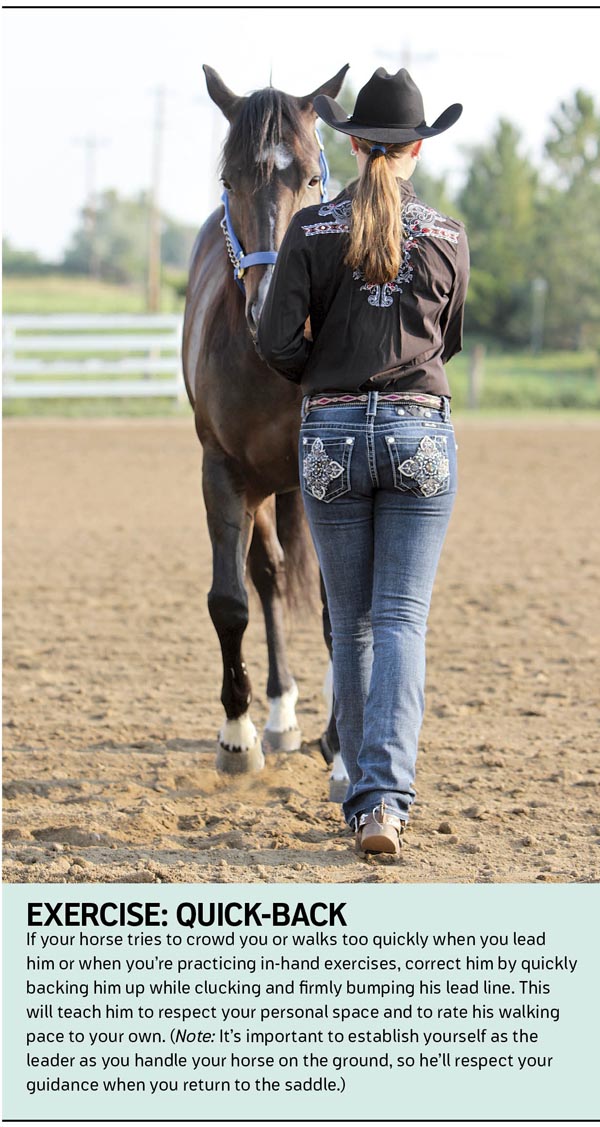
For example, spend five or 10 minutes brushing him or mucking his stall. As you do, see what new things you can learn about your horse. Observing his individual quirks, mannerisms, and traits will familiarize you with his personality, which in turn will enable you to relate to him better when you do ride. Your connection with your horse is like any friendship. The more time you spend together, the more in-sync you’ll be.
Ultimately, even if you’re permanently unable to ride or your horse is physically limited by unsoundness or age, you can still maintain a quality relationship with him simply by being with him and caring for him.






